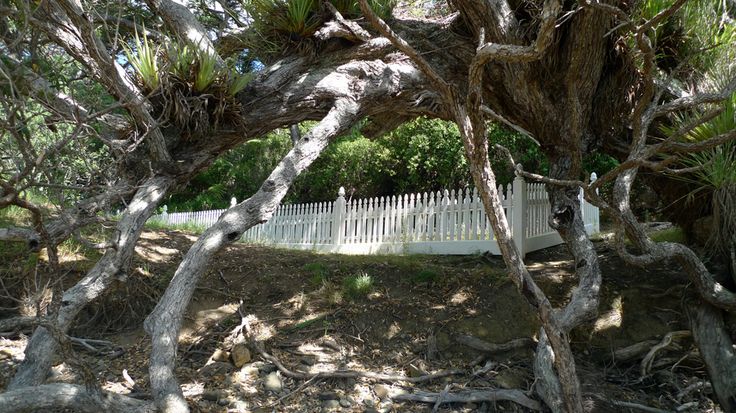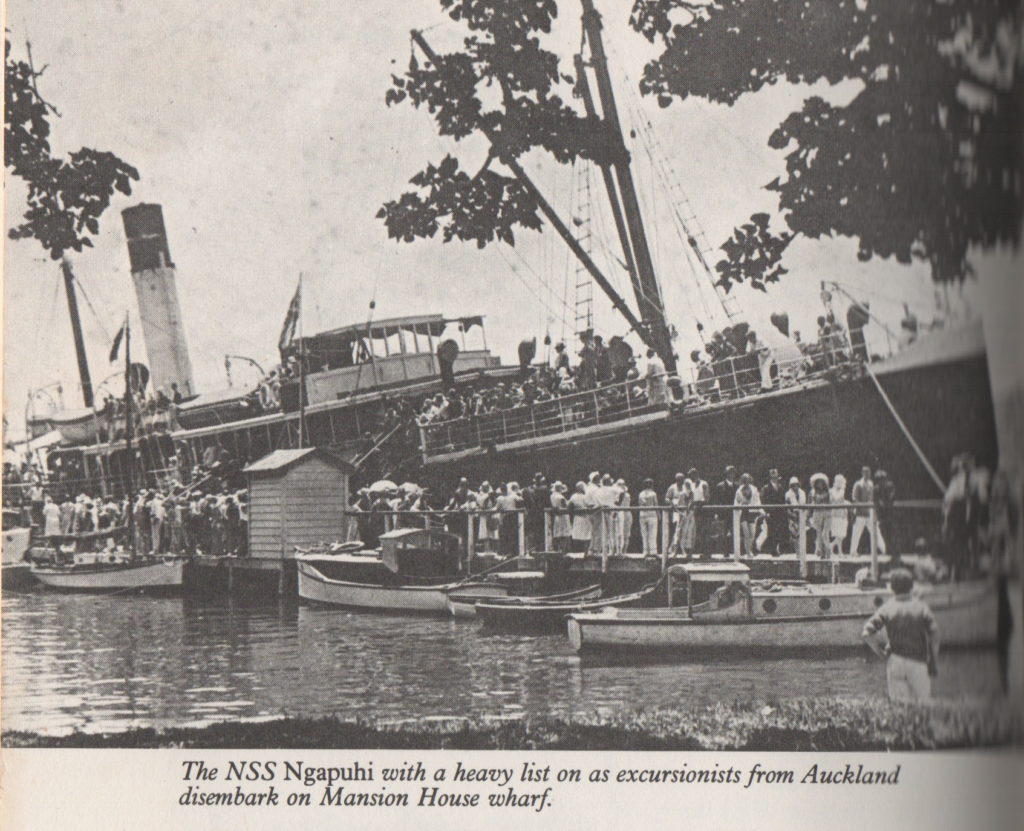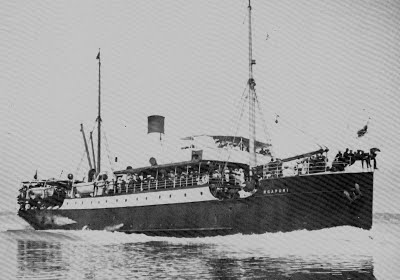The summer cruise ship season is again under way. Huge floating hotels, each carrying thousands of passengers, dock for a short time at a number of ports in both the North and South Island of New Zealand. Each visit provides a boost to the local economy. However cruising around the New Zealand coastline is nothing new.
At the turn of the 20th century it cost 7 pounds, a large amount of money at the time, for 9 days of discovery marketed as the ‘Grand Annual Pleasure Cruise along the Northern Coast’ The cruise took passengers to Great Barrier, the Hen & Chicken Islands, Whangarei, the Bay of Islands, Whangaroa Harbour, Totara North, Mangonui, Doubtless Bay, Kawau Island and Waiwera.
By the early 1900s, New Zealand had finally settled into a period of steady growth. The drift north was well under way and Auckland was quickly developing into a major centre. At the same time, New Zealanders eagerly embraced the more liberal Edwardian attitudes that followed the hard work ethic of the Victorian period. Day excursions became popular as people began to enjoy an increasing amount of free time.
During the first few years of the century, coastal shipping remained the main means of transport between the scattered settlements around the colony. (Movement overland was still an arduous undertaking) In 1904, the Northern Steamship Company came up with the idea of an extended cruise to tap the emerging number of citizens with a disposable income and some spare time on their hands.
FIRST CRUISE
The SS Ngapuhi departed Auckland on the inaugural cruise in January 1904, with 25 passengers onboard. It was a disappointment for a company that had expected at least double that number. Advertised as ‘an ideal summer trip’, it turned out to be exactly that. However, only 5 cruises were ever operated. The last left on the 14th February 1908.
The ship provided a library and a dark room for developing photographs. The food was top quality and there was even entertainment onboard. The delighted passengers returned full of praise for the exciting adventure they had experienced. The following year, word of mouth resulted in an impressive 90 bookings. The company knew it would be a squeeze on a converted cargo vessel better suited to accommodate roughly half that number, but this second Ngapuhi cruise was also a resounding success.
The Ngapuhi sailed through the first night to anchor at dawn in Fitzroy Harbour, Great Barrier Island. Eager passengers caught enough haupuka by simply dropping lines over the ship’s side to feed all onboard for breakfast before rowboats ferried them ashore to explore the heavily wooded slopes above the beach.
REMEMBERING A DISASTER
The next stop was at Katherine Bay where the holidaymakers lined up for a formal photograph in front of the picket fence erected around the grave of the Wairarapa victims. A decade earlier, 120 were drowned when the ship, on a voyage from Sydney to Auckland, slammed into a nearby cliff. Passengers lined the deck in silence as the Ngapuhi sailed north past the Wairarapa disaster site. The sadness that swept over them soon passed when the captain introduced a variety of deck games.
 Wairarapa Memorial Katherine Bay (tanyahutley.com)
Wairarapa Memorial Katherine Bay (tanyahutley.com)
EARLY SIGHTSEEING TRIP
A leisurely day at sea was interrupted by a short stop to allow the most adventurous to clamber over the slippery rocks which make up the Hen and Chicken Islands. Dinner was served after the ship had safely docked at Whangarei. From this northern town of over 2000 settlers, the Ngaphui passengers experienced their first taste of real sightseeing. They split into groups to be carted to a number of attractions. Some sampled grapes from recently established orchards while others visited the Kamo mineral springs and the Whangarei Falls. The limestone rocks at Waro proved a spectacular backdrop for a group photo. That evening the Ngapuhi steamed onto the Bay of Islands.
Refreshed after a night’s sleep, the travellers clambered up Flagstaff Hill to look down on sleepy little Russell. The only real attraction in the area was the historic Christ Church. Later that morning, a small steamer was laid on to ferry the group first to Waitangi, then onto the Haruru Falls. The day was capped off with a social function in the Russell town hall. It was a great way to end another exciting day.
On awaking the next morning, passengers had breakfast while the ship lay at anchor in Whangaroa Harbour. They would remain there for two days. A small launch was on hand to ferry the group around some of the local scenic attractions before they were deposited on a hillside for a sumptuous picnic.
The second day was occupied by climbing as many high points as possible. Clunky cameras of the period clicked at every opportunity as the passengers marvelled at the scenery. They also marvelled at the thundering death of a huge kauri tree that was felled for their entertainment. In fact, a tramp into the bush to witness kauri milling was regarded as a highlight of the cruise.
The next day, after a short voyage north, the travellers visited the Pacific Cable Station isolated on a rise overlooking windswept Doubtless Bay. The communications technology employed there no doubt impressed the fascinated group, especially when they witnessed a message being sent, then an incoming message reporting the current temperature in Brisbane. Following this, a regatta was held between passengers and crew. That evening, the Ngapuhi turned and headed south to drop anchor the following dawn near Mansion House, Kawau Island. It was the last day of their holiday and many photos were taken to remember the adventure. The last stop was at Waiwera before the ship steamed back to base in Auckland.
 SS Ngapuhi at Kawau Island (waitematawoody.com)
SS Ngapuhi at Kawau Island (waitematawoody.com)
Between 1904 and 1908, roads improved dramatically and railways began to carry more passengers. The new excitement of land travel had gripped the population. Advertised coastal cruises around New Zealand died. The Ngapuhi survived until November 1944, when she was beached on Rangitoto Island to become a rusting relic of New Zealand steamship history.
Ceidrik Heward
Ceidrik Heward is an Amazon TOP SELLING AUTHOR and has lived and worked in 7 countries working as a TV cameraman, director and film tutor. For the past 17 years he has focused on writing and has been published in magazines and newspapers in Europe, USA, Asia and the Middle East.
His interests include photography, psychology and metaphysics. He loves to read and always has at least 3 books on the go. He has written 22 manuals/books and has just completed his 4th short novel. Ceidrik believes sharing information and stories is the best way to stimulate the imagination and enrich our lives.





















 Visit Today : 371
Visit Today : 371 Total Visit : 1133548
Total Visit : 1133548
Speak Your Mind